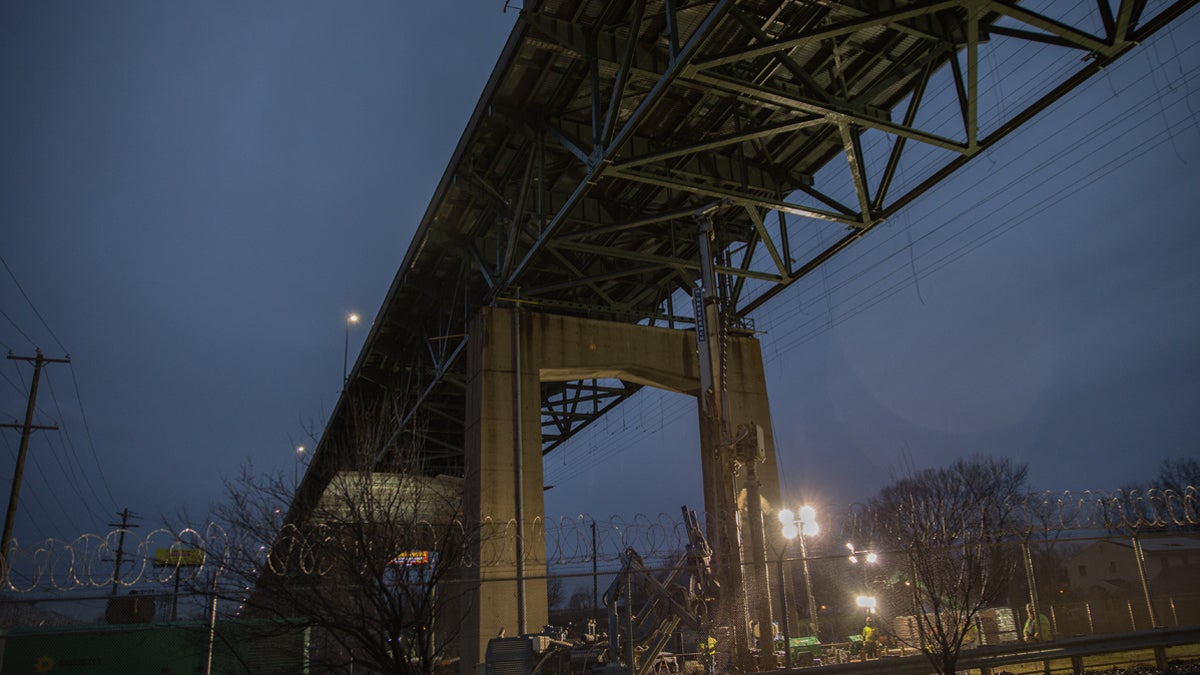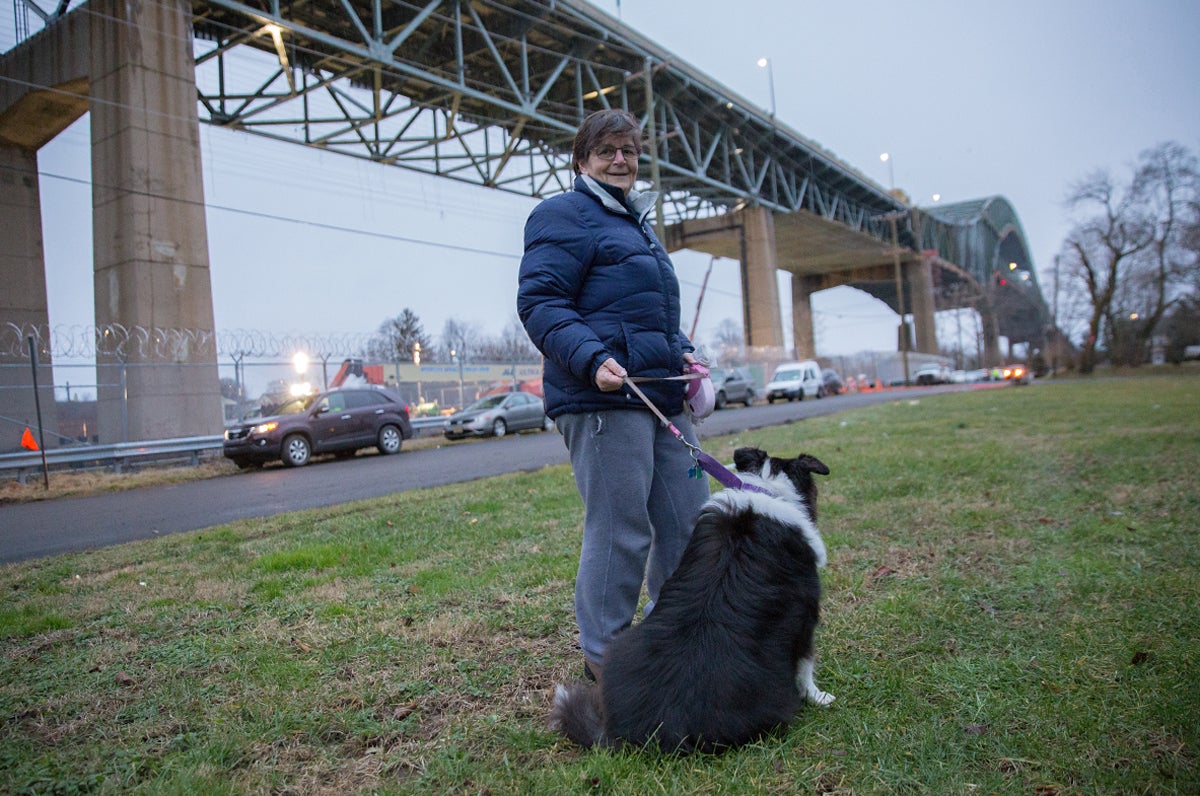Repairs, questions remain about Delaware River Bridge closure

Engineers work to repair a fracture on the Delaware River Bridge in Bristol
Last week, the bridge connecting the Pennsylvania and New Jersey turnpikes was closed for emergency repair. What does the bridge’s closure mean for the future of Pennsylvania’s 60,000 bridges and the people who live near them?
For 36 years, retired pediatric surgeon B.J. Bomentre has lived within shouting distance of the Delaware River Bridge, a 1.2-mile span that connects the New Jersey and Pennsylvania turnpikes. She lives in Bristol, on the Pennsylvania side, and since the discovery of a fracture in a steel beam forced officials to shut the bridge down last week, she’s witnessed the round-the-clock repair work. Bomentre expected some additional noise, but she certainly didn’t count on it being more nerve-racking than the 42,000 vehicles that rumble across the bridge daily.
She was wrong.
The incessant reverberating of drills, the mind-numbing hammering, the flames and sparks coming from welding equipment, and the blinding spotlights that stay on until the wee hours of the night make Bomentre wish for the everyday noises of the bridge traffic.
“It looks like the Barnum & Bailey circus out here,” she said of the bevy of engineers, inspectors and workers on site. “It looks like daylight when those lights go on at night, and then I see this unsettling torch with sparks flying everywhere and I’m thinking, ‘What the heck?….'”
 Dr. B.J. Bomentre walks her dog, Lady, near the closed Delaware River Bridge in Bristol, Pennsylvania. (Lindsay Lazarski/WHYY)
Dr. B.J. Bomentre walks her dog, Lady, near the closed Delaware River Bridge in Bristol, Pennsylvania. (Lindsay Lazarski/WHYY)
A reason for the fracture
It appears Bomentre and her neighbors will be forced to cope with the chaos indefinitely, or at the very least, several more weeks, until engineers figure out the cause of the fracture and repair it. It’s a slow, grueling process, as workers construct eight 70 to 80-foot shoring towers to support the weight of the 60-year-old bridge so other parts of the span won’t be compromised.
“It was a traumatic break,” New Jersey Turnpike spokesman Tom Feeney said. “This is not a little crack that deteriorated. It’s a big facture, and other steel components were affected by this. It will take a lot work to get the steel back to the original position to carry the load as it was designed to carry it.”
Once the bridge is stabilized, the actual repair work can begin. Turnpike Commission officials are still investigating the cause, but according to engineering experts, it appears the fracture occurred because holes in the beam were filled with weld metal, which performs differently than the materials around it.
“Whatever made the crack happen made it happen because it was a weak area,” said Joseph Martin, professor of civil engineering at Drexel University. “When you do all that welding, it heats up then cools down and leaves residual stresses in it…A series of heavily-loaded trucks may have pushed it over the edge, but despite its flaws it lasted for 60 years, so why now?”
Though the bridge was recently inspected in 2014, those are the kinds of questions engineers expect to answer once a thorough assessment is made. Pennsylvania Turnpike Commission spokesman Carl DeFebo, Jr. said it doesn’t matter if the state is losing an estimated $150,000 a day in tolls, the investigation will take as much time as it needs.
“It’s very important we understand the reason and the scope of the problem to make sure we’re protecting the safety of travelers,” DeFebo said. “Engineering is a science but sometimes it’s about solving a mystery. The last thing we want to do is hurry a decision along.”
Could other bridges be affected?
The bridge’s closure isn’t only impacting Bomentre and her neighbors. Thousands of motorists have found themselves ensnared in nightmarish commutes. Truckers whose livelihoods depend on delivering their loads on time are forced to re-route. The cost of the bridge repair may mean putting other capital projects on hold, such as the widening lanes on the turnpike or tollbooth reconstruction, DeFebo said.
But the biggest concern officials have is what the results of the investigation may reveal about the integrity of Pennsylvania’s 60,000 bridges. If such a serious structural flaw was discovered on the Delaware River Bridge simply by happenstance — during a routine inspection of a recent paint job — could similarly constructed bridges also be compromised?
“It’s too soon to say,” said DeFebo, who stressed that Pennsylvania’s state bridges are inspected every two years. “Each bridge is constructed differently. There are older bridges; there are newer bridges. Engineers first want to find the cause before they determine whether it will affect the other bridges.”
In the meantime, Bomentre vows to be patient with the process. But she looks forward to those peaceful sounds of double flatbed trucks again.
“This is a very busy bridge,” she said, “but I’ve gotten used to it.”
WHYY is your source for fact-based, in-depth journalism and information. As a nonprofit organization, we rely on financial support from readers like you. Please give today.


